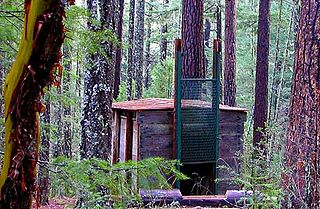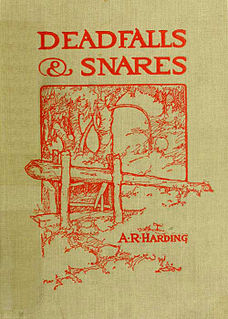 W
WAnimal trapping, or simply trapping, is the use of a device to remotely catch an animal. Animals may be trapped for a variety of purposes, including food, the fur trade, hunting, pest control, and wildlife management.
 W
WWhat is believed to be the world's only Bigfoot trap is located in the Siskiyou National Forest in the southern part of Jackson County, Oregon, a few miles from the California state border. It was designed to capture a Bigfoot, the legendary hominid that is said to live in the forests of the Pacific Northwest.
 W
WBird trapping techniques to capture wild birds include a wide range of techniques that have their origins in the hunting of birds for food. While hunting for food does not require birds to be caught alive, some trapping techniques capture birds without harming them and are of use in ornithology research. Wild birds may also be trapped for their display in captivity in zoological gardens or for keeping as a pet. Bird trapping was formerly unregulated, but to protect bird populations most countries have specific laws and regulations.
 W
WDeadfalls and Snares: A Book of Instruction for Trappers About These and Other Home-Made Traps is a 1907 book by A. R. Harding.
 W
WA flight interception trap is a widely used trapping, killing, and preserving system for flying insects. It is especially well-suited for collecting beetles, since these animals usually drop themselves after flying into an object, rather than flying upward. Flight Interception Traps are mainly used to collect flying species which are not likely to be attracted to bait or light.
 W
WArchibald Stansfeld Belaney, commonly known as Grey Owl, was a British-born conservationist, fur trapper, and writer who disguised himself as a Native American man. While he achieved fame as a conservationist during his life, after his death the revelation that he was not Indigenous, along with other autobiographical fabrications, negatively affected his reputation.
 W
WInsect traps are used to monitor or directly reduce populations of insects or other arthropods, by trapping individuals and killing them. They typically use food, visual lures, chemical attractants and pheromones as bait and are installed so that they do not injure other animals or humans or result in residues in foods or feeds. Visual lures use light, bright colors and shapes to attract pests. Chemical attractants or pheromones may attract only a specific sex. Insect traps are sometimes used in pest management programs instead of pesticides but are more often used to look at seasonal and distributional patterns of pest occurrence. This information may then be used in other pest management approaches.
 W
WA malaise trap is a large, tent-like structure used for trapping, killing, and preserving flying insects, particularly Hymenoptera and Diptera. The trap is made of a material such as PET (polyester) netting and can be various colours. Insects fly into the tent wall and are funneled into a collecting vessel attached to its highest point. It was invented by René Malaise in 1934.
 W
WMink Trapping – A Book of Instruction Giving Many Methods of Trapping – A Valuable Book for Trappers.
 W
WMoth traps are devices used by entomologists to capture moths. Most use a light source. Pheromone traps are also used.
 W
WThe abundant painted turtle species is captured from the wild, primarily for pet use. Commercial harvesting is a small-scale industry that faces growing restrictions, but still occurs, in some cases unconstrained. Recreational harvesting, is generally allowed in much of the species range. However, it is prohibited in areas where the species is threatened and in a few non-threatened locations. Generally, turtles are captured by live trapping. Floating basking-style traps work better than staked, baited hoop-style traps, but both are employed. Because the turtles are long-lived, with lower replacement rates than typical game, concerns exist for over-harvesting. In this, they are similar to species such as snapping turtles, with late-aged sexual maturity, albeit not to the same extent.
 W
WA pitfall trap is a trapping pit for small animals, such as insects, amphibians and reptiles. Pitfall traps are a sampling technique, mainly used for ecology studies and ecologic pest control. Animals that enter a pitfall trap are unable to escape. This is a form of passive collection, as opposed to active collection where the collector catches each animal. Active collection may be difficult or time-consuming, especially in habitats where it is hard to see the animals such as thick grass.
 W
WThe Sherman trap is a box-style animal trap designed for the live capture of small mammals. It was invented by Dr. H. B. Sherman in the 1920s and became commercially available in 1955. Since that time, the Sherman trap has been used extensively by researchers in the biological sciences for capturing animals such as mice, voles, shrews, and chipmunks. The Sherman trap consists of eight hinged pieces of sheet metal that allow the trap to be collapsed for storage or transport. Sherman traps are often set in grids and may be baited with grains and seed.
 W
WThe Steam House is an 1880 Jules Verne novel recounting the travels of a group of British colonists in the Raj in a wheeled house pulled by a steam-powered mechanical elephant. Verne uses the mechanical house as a plot device to have the reader travel in nineteenth-century India. The descriptions are interspersed with historical information and social commentary.
 W
WTrapping pits are deep pits dug into the ground, or built from stone, in order to trap animals. European rock drawings and cave paintings reveal that red deer and elk/moose were hunted since the Stone Age using trapping pits. Remains of trapping pits used for hunting elk, reindeer, wolves, and bears can still be found in Northern Scandinavia. These pits, which can measure up to 4 by 7 metres in size and be up to several metres deep, were camouflaged with branches and leaves. They had steep sides lined with planks or masonry, making it impossible for the animal to escape once it had fallen in. When the animal had fallen into the pit, it was killed, either bled to death by sharpened sticks pointed upwards from the bottom of the pit, or in the case of pits without these sticks, dispatched by hunters waiting nearby. Some traps had a small rope enabling rodents and amphibians to escape.
 W
WYukon Men is an unscripted American cable television series aired on the Discovery Channel. It is produced by Paper Route Productions and premiered on August 24, 2012.